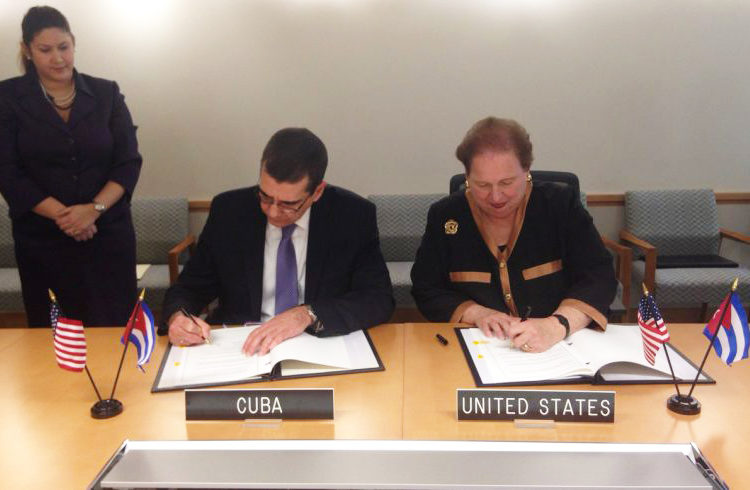In less than 12 hours the governments of Cuba and the United States signed this Wednesday three agreements that allow for maritime exchange, the conservation of protected areas and the demarcation of its borders in the waters of the Gulf, thus surpassing the 20 bilateral instruments signed since the reestablishment of diplomatic relations.
The first, consolidated as a binding agreement, refers to maritime and aeronautical search and rescue and allows for carrying out joint actions as well as the monitoring of the communication channels in those areas.
This cooperation project signed on Wednesday morning in the Hotel Nacional de Cuba by Jeffrey DeLaurentis, chargé d’affaires of the U.S. embassy, and Marta Oramas, the island’s deputy minister of transportation, could also include carrying out joint exercises, reciprocal visits by experts and the exchange of information.
The Cuban Foreign Ministry affirmed in its official page that the fundamental objective of this agreement is “to allow both countries’ coordinated action in assisting persons in danger.”
“We are strengthening this cooperation between both nations in our shared effort to save lives,” said DeLaurentis, who recalled that as a precedent since 2013 there has existed an Operational Procedure for Aeronautical and Maritime Search and Rescue between Cuba and the United States.
And as part of this hurried agenda of negotiations that has been generated by the Obama administration, in the afternoon another agreement was signed in the venue of the Department of State in Washington that sets the territorial limits of the Eastern Zone in the waters of the Gulf.
Already on January 9 DeLaurentis and Eduardo Rodríguez, Cuban deputy minister of transportation, had signed an agreement for the prevention of oil spills and the spilling of other toxic substances in the Gulf of Mexico and the Straits of Florida. At the time an agreement that would define the geographical limits corresponding to Cuba, Mexico and the United States in the “Doughnut Hole” was expected before next January 20, given that since July 2016 a round of consultations had been initiated in Mexico to provide legal advice to the three countries for the free exercise of their rights in the common border of the Gulf of Mexico.
While Mexico is one of the three implicated countries, only the signing of the agreement between Cuba and the United States has been made public, with which a demarcation has been drawn up “according to International Law, the continental shelf between the Republic of Cuba and the United States of America in the Eastern Zone of the Gulf of Mexico beyond the 200 Nautical Miles,” as was announced by the Cuban Foreign Ministry.
This agreement – the 20th between Cuba and the United States – was signed by José Ramón Cabañas, Cuban ambassador to the United States, and Mari Carmen Aponte, acting Assistant Secretary of State for Western Hemisphere Affairs of the U.S. Department of State.
A few minutes after the demarcation of Cuba’s borders in the Gulf of Mexico was known, the Foreign Ministry also announced a tool agreement between the Ciénaga de Zapata National Park in Matanzas and the Everglades National Park in Florida. This agreement “has the purpose of contributing to the environmental management of these protected areas through the exchange of information, modern practices for the sustainable management of the resources they conserve and scientific knowledge in this sphere.”
The agreement is added to the Memorandum of Understanding on the Conservation of Wildlife and the Protected National Land Areas signed last December 21 in Washington.
In the face of Donald Trump’s threat that he will revert the policy of rapprochement to the island, President Barack Obama is hurrying up to take his last measures of cooperation between the two countries, thus presumably other agreements will arrive before Trump’s inauguration on Friday the 20th.









